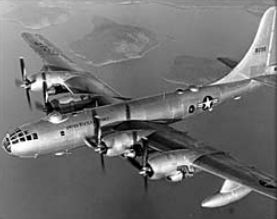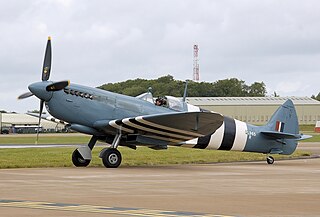
The Boeing RC-135 is a family of large reconnaissance aircraft built by Boeing and modified by a number of companies, including General Dynamics, Lockheed, LTV, E-Systems, and L3 Technologies, and used by the United States Air Force and Royal Air Force to support theater and national level intelligence consumers with near real-time on-scene collection, analysis and dissemination capabilities.

The Lockheed U-2, nicknamed "Dragon Lady", is an American single-engine, high altitude reconnaissance aircraft operated from the 1950s–2020s by the United States Air Force (USAF) or the Central Intelligence Agency (CIA). It provides day and night, high-altitude, all-weather intelligence gathering.

The Boeing B-47 Stratojet is a retired American long-range, six-engined, turbojet-powered strategic bomber designed to fly at high subsonic speed and at high altitude to avoid enemy interceptor aircraft. The primary mission of the B-47 was as a nuclear bomber capable of striking targets within the Soviet Union.

The Convair B-36 "Peacemaker" is a strategic bomber that was built by Convair and operated by the United States Air Force (USAF) from 1949 to 1959. The B-36 is the largest mass-produced piston-engined aircraft ever built. It had the longest wingspan of any combat aircraft ever built, at 230 ft (70 m). The B-36 was the first bomber capable of delivering any of the nuclear weapons in the U.S. arsenal from an internal bomb bay without aircraft modifications. With a range of 10,000 mi (16,000 km) and a maximum payload of 87,200 lb (39,600 kg), the B-36 was capable of intercontinental flight without refuelling.

The North American B-45 Tornado was an early American jet bomber designed and manufactured by aircraft company North American Aviation. It has the distinction of being the first operational jet bomber to enter service with the United States Air Force (USAF), as well as the first multiengine jet bomber to be refueled in midair.

The Martin B-57 Canberra is an American-built, twin-engined tactical bomber and reconnaissance aircraft that entered service with the United States Air Force (USAF) in 1953. The B-57 is a license-built version of the British English Electric Canberra, manufactured by the Glenn L. Martin Company. Initial Martin-built models were virtually identical to their British-built twinjet counterparts; Martin later modified the design to incorporate larger quantities of US-sourced components and produced the aircraft in several different variants.

The Boeing B-50 Superfortress is an American strategic bomber. A post–World War II revision of the Boeing B-29 Superfortress, it was fitted with more powerful Pratt & Whitney R-4360 radial engines, stronger structure, a taller tail fin, and other improvements. It was the last piston-engined bomber built by Boeing for the United States Air Force, and was further refined into Boeing's final such design, the prototype B-54. Although not as well known as its direct predecessor, the B-50 was in USAF service for nearly 20 years.

The Boeing B-29 Superfortress is a WWII era long range, strategic heavy bomber that was produced in many experimental and production models.

The development of the Convair B-36 strategic bomber began in 1941 with the XB-36, which was intended to meet the strategic needs of the US Army Air Forces, and later of the United States Air Force with its Strategic Air Command. In 1948, the B-36 become a mainstay of the American nuclear deterrent. It underwent a number of design changes before being withdrawn from service in 1959. It was also well suited to high altitude very long range reconnaissance missions, and several alterations were made with this mission profile in mind.

The FICON program was conducted by the United States Air Force in the 1950s to test the feasibility of a Convair B-36 Peacemaker bomber carrying a Republic F-84 Thunderflash parasite fighter in its bomb bay. Earlier wingtip coupling experiments included Tip Tow, which were attempts at carrying fighters connected to the wingtips of bombers. Tom-Tom followed the FICON project afterwards.

Aerial reconnaissance is reconnaissance for a military or strategic purpose that is conducted using reconnaissance aircraft. The role of reconnaissance can fulfil a variety of requirements including artillery spotting, the collection of imagery intelligence, and the observation of enemy maneuvers.

The Martin/General Dynamics RB-57F Canberra is a specialized strategic reconnaissance aircraft developed in the 1960s for the United States Air Force by General Dynamics from the Martin B-57 Canberra tactical bomber, which itself was a license-built version of the English Electric Canberra. It was operationally assigned to the Air Weather Service for weather reconnaissance involving high-altitude atmospheric sampling and radiation detection in support of nuclear test monitoring, but four of the 21 modified aircraft performed solely as strategic reconnaissance platforms in Japan and Germany.

The Martin RB-57D Canberra was a specialized high-altitude strategic reconnaissance aircraft developed from the Martin B-57 Canberra tactical bomber, a licence-built version of the English Electric Canberra. It was used by the United States Air Force during the 1950s prior to operational use of the Lockheed U-2.

The 7499th Support Group is an inactive United States Air Force organization. Its last assignment was with the United States Air Forces in Europe, being stationed at Wiesbaden Army Airfield, West Germany. It was inactivated on 30 June 1974. Its mission was resumed by the 7575th Operations Group, which operated from Rhein-Main Air Base, West Germany from 1 July 1977 until its inactivation on 31 March 1991.

The 6091st Reconnaissance Squadron is an inactive United States Air Force unit. Its last was assigned to the 41st Air Division, stationed at Yokota Air Base, Japan. It was inactivated on 1 July 1968.

The 6021st Reconnaissance Squadron is an inactive United States Air Force unit. Its last was assigned to the 67th Tactical Reconnaissance Wing, stationed at Yokota Air Base, Japan. It was discontinued on 8 December 1957.

The 6007th Reconnaissance Group is an inactive United States Air Force unit. Its last was assigned to the 6007th Reconnaissance Wing, stationed at Yokota Air Base, Japan. It was discontinued on 9 August 1957.

A transformational growth in aerial reconnaissance occurred in the years 1939–45, especially in Britain and then in the United States. It was an expansion determined mostly by trial and error, represented mostly by new tactics, new procedures, and new technology, though rarely by specialized aircraft types. The mission type branched out into many sub-types, including new electronic forms of reconnaissance. In sharp contrast with the case during the pre-war years, by 1945 air reconnaissance was widely recognized as a vital, indispensable component of air power.
















